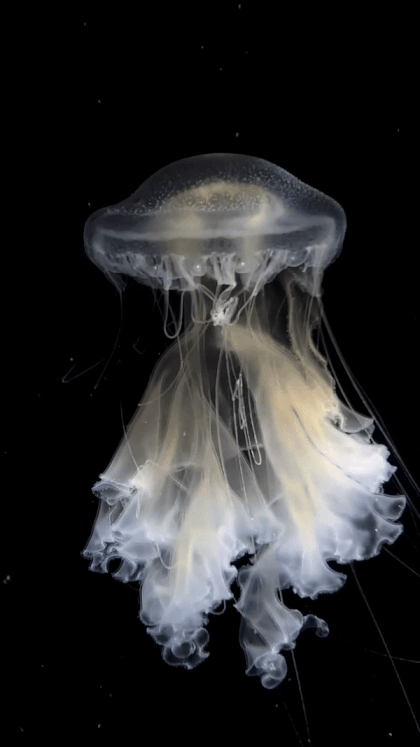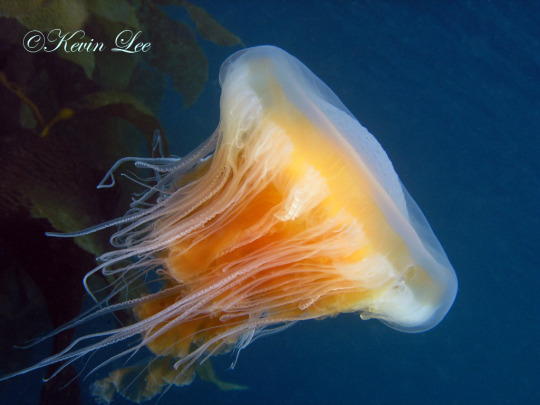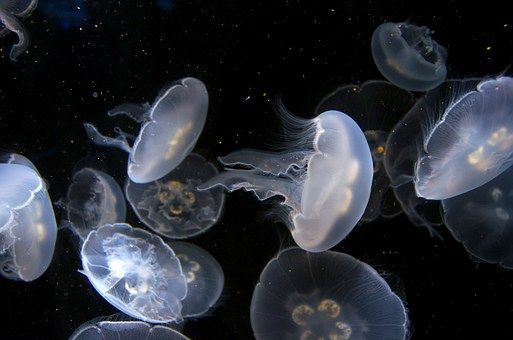#Phacellophora camtschatica
Explore tagged Tumblr posts
Text
youtube
Some moments from nightlighting this year in the Salish Sea.
In order of appearance, this video features:
0:00 - Dendronotus iris, the giant nudibranch - first shown up close to show off its highly branched cerata, and then seen swimming. 0:22 - A harbor seal, Phoca vitulina richardii, swimming around the light while it hunts fish. 0:39 - Shrimp and fish circling the light. 1:08 - A squid jets by 1:12 - thousands of long thin larval fish school around the light 1:20 - A large cross jellyfish, Mitrocoma cellularia, pulses its bell to swim, fanning out its many fine tentacles 1:30 - many small fish swarm the pale blue light, blotting out portions of it 1:52 - a long yellow polychaete worm dances and weaves through the water column 2:04 - the crystal jellyfish, Aequorea victoria, swims with an incredible amount of Pleurobrachia bachei ctenophores and other animals in the background and then we zoom past to see more ctenophores. 2:18 - an egg yolk jelly, Phacellophora camtschatica swims by in deep blue water 2:30 - a nudibranch with long narrow cerata, Cumanotus sp., swims by swinging its body back and forth, whipping its cerata around. 2:43 - a sea gooseberry, Pleurobrachia bachei, spins through its fanned out tentacles in a gorgeous dance 2:57 - a small hydrozoan jelly with a yellow mouth and dots around its bell, Proboscidactyla flavicirrata, bounces, pulses, and then turns to the side showing off its branched radial canals 3:11 - a sea gooseberry, Pleurobrachia bachei, spins and casts rainbows with its ctenes, mouth up to the camera 3:21 - an odd gregarious jelly, Clytia gregaria, with an extra radial canal giving it a star shaped mouth, swims in the dark 3:27 - outro card "Thanks for Watching" with instagram, facebook, and bluesky icons and the handle @NonCompliantCyborg
#nightlighting#video#nudibranch#sea slug#seal#jellyfish#ctenophore#comb jelly#Clytia gregaria#Pleurobrachia bachei#Aequorea victoria#Proboscidactyla flavicirrata#polychaete#Mitrocoma cellularia#Phacellophora camtschatica#Phoca vitulina richardii#Dendronotus iris#Cumanotus#squid#Doryteuthis opalescens#my videos#Youtube
6 notes
·
View notes
Text

phacellophora camtschatica :)
37 notes
·
View notes
Text
Jellyfish identified !
Fried Egg Jellyfish - Phacellophora Camtschatica
BIOLOGY: This jellyfish has quite the debated classification. It was originally thought to be part of the Ulmaridae family (moon jellyfish), and then of the Cyaneidae family (lion's mane jellyfish); but was ultimately determined as part of a brand new family altogether: Phacellophoridae. However, that classification could change in the coming years. This species is also the sole known species in that family, but three or four more as suspected to exist: as such, the classification of the particular specimen in this post could be identified as incorrect when more light is shed on the matter.
That said, this species of jellyfish usually bears a yellow center with a translucent bell: earning it the name of fried-egg jellyfish. Although of course some individuals vary in color, being either nearly colorless or wholly yellow. They also have curtain-like oral arms, and a weak sting.
LOCATION: These jellies reside in cool waters, but aren't an extremely common sight. They have mainly been recorded in parts of the Sea of Japan and the Sea of Okhotsk, although they can be seen around the world.
SIZE: An adult specimen's bell can range from approx. 12 inches (60cm) with tentacles as long as 20 feet (6 meters).
GALLERY:







>> the_story_of_a_biologist
#jellyfish#jellyfish identified#jellyf id#fried egg jellyfish#phacellophora camtschatica#marine biology#marine life#sea life#ocean
18K notes
·
View notes
Text

Fried egg jellyfish!
#photos#jellyfish#sea jelly#not sure if this is Phacellophora camtschatica or Cotylorhiza tuberculata#source suggests the latter but it looks more like the former
3 notes
·
View notes
Text
That one time we spotted a jellyfish with googly eyes 👀
This egg-yolk jelly, Phacellophora camtschatica, is playing host to a couple of barnacles growing on its bell. These slow-moving jellies can grow up to two feet (61 centimeters) in diameter and have hundreds of tentacles that extend over 20 feet (six meters) in length. This species often plays host to other animals like the medusa fish, Icichthys lockingtoni.
Our researchers observed this individual at 826 meters (2,700 feet) deep in Monterey Bay. These barnacles are most likely Alepas pacifica, known to be a symbiont of jellyfish.
667 notes
·
View notes
Note
Fried egg jellyfish :3


Photos thanks to Karolle Wall & Kevin Lee, respectively. Cotylorhiza tuberculata, the Mediterranean jellyfish, is another species which is commonly called the fried egg jellyfish :)
#fried egg jellyfish#jellyfish#cnidarian#scyphozoa#semaeostomeae#marine life#invertebrates#invertiblr#marine invertebrates#animal polls#poll blog#animals#my polls#polls#tumblr polls
67 notes
·
View notes
Text

Phacellophora, commonly known as the fried egg jellyfish or egg-yolk jellyfish, is a very large jellyfish in the monotypic family Phacellophoridae containing a single species Phacellophora camtschatica. This genus can be easily identified by the yellow coloration in the center of its body which closely resembles an egg yolk, hence its common name. Some individuals can have a bell close to 60 cm (2 ft) in diameter, and most individuals have 16 clusters of up to a few dozen tentacles, each up to 6 m (20 ft) long. A smaller jellyfish, Cotylorhiza tuberculata, typically found in warmer water, particularly in the Mediterranean Sea, is also popularly called a fried egg jellyfish. Also, P. camtschatica is sometimes confused with the Lion's mane jellyfish (Cyanea capillata). - Wikipedia
76 notes
·
View notes
Text

Fried Egg Jellyfish (Cotylorhiza tuberculata)
A lot of people’s favorite! The Fried Egg Jellyfish, also known as the Egg-Yolk Jellyfish is such a unique looking creature. How could I resist drawing this beauty!
Some specimens of this species have a bell that reaches up to 40cm, or 60in, in diameter. It is (obviously) easily identified by the yellow coloration in the center of its body, which is very reminiscent of an egg yolk. There is a larger version of this species, scientific name Phacellophora camtschatica that can reach up to 60cm, or 2 feet, in diameter!
The Cotylorhiza resides in the Mediterranean and is commonly found in the Mediterranean Sea, Aegean Sea, and Adriatic Sea. The sting of this jellyfish is not very effective on humans, but can cause allergies in people who may be more sensitive.
The diet of the Fried Egg Jellyfish consists of minuscule, aquatic organisms such as phytoplankton and zooplankton. The Fried Egg Jellyfish have “mouth arms” through which they take these minuscule organisms and transport them to the jellyfish’s stomach.
Interestingly enough, these jellyfish house endosymbiotic, photosynthetic algae within their bodies known as zooxanthellae. Zooxanthellae commonly form symbiotic relationships with many species of jellyfish, and use their photosynthetic abilities to produce energy for use and storage by the jellyfish host.
The Fried Egg Jellyfish has been studied due to their specified cytotoxicity in regards to certain breast cancer cells. Love that! You know we’re all about those Double D’s!
#art#artist#digital art#digital artist#drawing#animals#artists on tumblr#jellyfish#jelly fish#fried egg#egg yolk#egg yolk jellyfish#fried egg jellyfish#Cotylorhiza tuberculata#oceancore#ocean#ocean life#sea creatures
14 notes
·
View notes
Text

the mediterranean jellyfish, cotylorhiza tuberculata; a species of jellyfish under the phylum of cnidaria
fun fact! it is also known as the fried egg jellyfish (not to be confused with the phacellophora camtschatica) 🍳
it can reach up to 40cm (16in) in diameter
its sting has little to no effect, but may cause allergies to some people
they have been studied for their cytotoxicity in regards to breast cancer cells
#cotylorhiza tuberculata#beautiful#jellyfish#marine#ocean#sea#the mediterranean jellyfish#interesting ocean
6 notes
·
View notes
Text
Jellyfish of the day
Fried Egg / Egg Yolk Jellyfish (phacellophora camtschatica)

9 notes
·
View notes
Text


The egg-yolk jelly, Phacellophora camtschatica.
Friday Harbor Labs, Washington. Spring 2021.
#jellyfish#marine biology#marine life#ocean aesthetic#oceancore#egg-yolk jelly#pacific northwest#friday harbor#washington#marine#mine
40 notes
·
View notes
Text

Alexander Semenov - Phacellophora camtschatica
#marine animals#marine life#underwater photography#photography#oceancore#ocean#nature#wildlife#flickr
9 notes
·
View notes
Text
HYPERDOLPHIN (ハイパードルフィン)
I realize that I haven't mentioned this very important band in Ite! that is central to Rankou's storyline so I should probably talk about it :>
Formed in his first year, HYPERDOLPHIN is pretty much just your run-of-the-mill high school band. The members are as follows:
Yamamoto Rankou (山本卵黄):

Leader / Bassist
Responsible for a lot of the planning and other management-related things for the band
Terrible at singing
Egg Yolk Jelly / Samukurage / Phacellophora camtschatica
[Last name pending] Kiseki (きせき):

Vocalist / Rhythm Guitarist
One of the founding members
A bit of a renaissance jelly when it comes to music
Cauliflower Jelly / Ibokurage / Cephea cephea
Nakachi Helios (中地ヘリオス):

Drummer
Ends up mooching snacks and spare change off of other members
Has Phasmophobia
Mediterranean Jellyfish / Chichoukai Ibokurage / Cotylorhiza tuberculata
Nozaki Yuune (野崎幽音):

Lead Guitarist
Exceptionally gifted at guitar
Pretty quiet and shy, has a habit of accidentally sneaking up on people
Ghost Jellyfish / Yuureikurage / Cyanea nozakii
#ite! it's jellyfish love!#HYPERDOLPHIN#everything I know about bands comes from BANDORI btw ;w;#my art#jellyfish#yuune nozaki#helios nakachi#rankou yamamoto#the idea of a jellyfish band sounds so fun ^-^ I can't wait to write everyone#everyone except Yuune has a gijinka design btw :>- I'm not sure how to draw her so it's taking a little while
17 notes
·
View notes
Text
10 Reasons to love Jellyfish
Finding more reasons to love Jellyfish? as if their existence alone isn't enough. Here are more reasons and facts about Jellyfish! But before we head into it, what is a Jellyfish?
Based on Wikipedia, Sea jellies, or Jellyfish, are the medusa phase of several gelatinous species of the subphylum Medusozoa, which is a significant portion of the phylum Cnidaria.

10 Reasons to Love Jellyfish
Jellyfish are 95 percent water. They don't have blood, a brain, bones, and a heart. though they have a nervous system with receptors that detect light, vibrations, and chemicals in the water.
There's some Jellyfish that are Immortal. Turritopsis dohrni also known as Immortal Jellyfish, are able to come back to life when they sense themselves that they are stress, sick, nor old.
Some species of Moon Jelly are capable of producing light through a chemical reaction in their bodies. Hence why they are able to glow in the dark.
Not all Jellyfish has tentacles. Deepstaria is a genus of jellyfish known for their thin, sheet-like bodies and their lack of tentacles.
There are 2,000 species of Jellyfish that Scientists had discovered, and 1,000 more to discover. which means there are more types of Jellyfish to learn!
Box Jellies are the only ones who have eyes and can see, rather than only sense light.
Jellyfish are found all over the world from surface waters to the deep sea! They are pretty much easy to spot on while you are diving or swimming in the ocean! (though, be careful they might slightly sting you as self defense!)
If there are Immortal Jellyfish there are some smaller species of jellyfish that has smaller lifespan. Like, flame jellyfish ( Rhopilema esculentum ) that has a short lifespan up to 4 months.
Phacellophora camtschatica and Cotylorhiza tuberculata are the species that looks like an egg!
Jellyfish are carnivores and can increase in size rapidly and procreate in large numbers when food is abundant.

Conclusion
Jellyfish are amazing animals with graceful movements and glowing displays that attract a lot of attention. They are important in the ocean because they control the number of tiny animals called zooplankton and small fish, and they also help with medical research. Their clever ways of adapting and surviving show how strong and smart they are.
if you still have no reasons to love jellyfish then you're missing out!
2 notes
·
View notes
Text
20 Fascinating Jellyfish Names: From Moon Jellies to Immortal Species
https://goteamnames.com/?p=1838 20 Fascinating Jellyfish Names: From Moon Jellies to Immortal Species Dive with us into the mesmerizing industry of jellyfish names, where these gelatinous creatures are as uniquely named as they are fascinating. From the deadly Box Jellyfish to the enchanting Moon Jellyfish, these marine organisms boast names that often reflect their appearance, behavior, or the danger they pose. We’ve compiled a comprehensive guide to help you identify and understand these translucent ocean dwellers. Whether you’re a marine biology enthusiast, an aquarium visitor, or simply curious about these pulsating creatures, knowing their names opens the door to appreciating their diversity. Let’s explore the terminology behind these ancient beings that have been floating through our oceans for over 650 million years. Table of Contents Toggle The Mesmerizing World of Jellyfish NamesMost Common Jellyfish Names and SpeciesMoon Jellyfish (Aurelia aurita)Lion’s Mane Jellyfish (Cyanea capillata)Box Jellyfish (Chironex fleckeri)Uniquely Named Jellyfish Based on AppearanceCrystal Jellyfish (Aequorea victoria)Flower Hat Jellyfish (Olindias formosus)Cauliflower Jellyfish (Cephea cephea)Jellyfish With Geographical NamesAtlantic Sea Nettle (Chrysaora quinquecirrha)Japanese Sea Nettle (Chrysaora pacifica)Mediterranean Jellyfish (Cotylorhiza tuberculata)Jellyfish With Names Inspired by MythologyMedusa Jellyfish (Various Scyphozoa)Cassiopea Jellyfish (Cassiopea andromeda)Atolla Jellyfish (Atolla wyvillei)Newly Discovered and Unusual Jellyfish NamesSt. George’s Cross Medusa (Santjordia pagesi)Tripedalia maipoensisBloodybelly Comb Jellyfish (Lampocteis cruentiventer)Immortal Jellyfish (Turritopsis dohrnii)Fried Egg Jellyfish (Phacellophora camtschatica)Understanding the Scientific Naming of JellyfishClassification and PhylaBinomial Nomenclature SystemCommon Names vs. Scientific NamesHow to Remember Jellyfish Names and Identify SpeciesFocus on Habitat and Geographic LocationExamine Physical CharacteristicsAssess Venomous PotentialLook for Distinctive FeaturesConnect Names to AppearancesThe Most Fascinating Jellyfish Names in the Ocean WorldFrequently Asked QuestionsWhat are jellyfish named after?How many jellyfish species have been identified?What is the most dangerous jellyfish?Can jellyfish names vary by region?What’s unique about the Immortal Jellyfish?How do scientists classify jellyfish?Are all “jellyfish” actually fish?What is a group of jellyfish called?How can I identify different jellyfish species?Why are some jellyfish named after mythological figures? The Mesmerizing World of Jellyfish Names Jellyfish names often reflect their distinctive physical characteristics, making them both memorable and descriptive. The Moon Jellyfish, for example, gets its name from its translucent, moon-like appearance that creates an ethereal glow in ocean waters. Naming patterns typically follow scientific classification systems while also incorporating common names based on appearance, habitat, or discoverer. Scientists have identified over 2,000 jellyfish species, each with unique naming conventions that help researchers classify these gelatinous creatures. Many names showcase vibrant descriptions such as the Lion’s Mane Jellyfish, named for its flowing tentacles that resemble a lion’s shaggy mane. Regional variations in jellyfish naming exist across different cultures, with some species having multiple common names depending on the location. Technological advances have enabled researchers to discover new jellyfish species regularly, leading to an expanding vocabulary of fascinating names. The Immortal Jellyfish earns its dramatic title from its unique ability to revert to an earlier life stage rather than dying, technically making it biologically immortal. Understanding these naming conventions helps us appreciate the incredible diversity found within the jellyfish industry. Jellyfish with dangerous reputations often receive names that serve as warnings, like the deadly Box Jellyfish or the painful Portuguese Man-of-War (which is technically not a true jellyfish but a colonial organism). These cautionary names play an important role in public safety education about marine dangers. Conservation efforts benefit from distinctive jellyfish names that help raise awareness about threatened species and their ecosystems. Most Common Jellyfish Names and Species Exploring the oceans reveals fascinating jellyfish species that have captivated scientists and beachgoers alike. Let’s examine some of the most recognizable jellyfish species you might encounter in waters around the industry. Moon Jellyfish (Aurelia aurita) Moon Jellyfish earned their name from their distinctive translucent, saucer-shaped bells that resemble full moons glowing in the water. These gentle creatures can be found swimming in temperate and tropical waters worldwide, including coastal areas and estuaries where they’re commonly spotted. Their bell diameter typically reaches up to 12 inches (30 cm), making them easily visible to swimmers and divers. Short, frilly tentacles surround their bell, creating a delicate appearance that belies their resilience as a species. We consider these jellyfish relatively harmless to humans, as they deliver only mild stings that rarely cause important discomfort or medical issues. Lion’s Mane Jellyfish (Cyanea capillata) Lion’s Mane Jellyfish stand as one of the ocean’s most magnificent and imposing species, named for their spectacular flowing tentacles that evoke the mane of a lion. These massive creatures boast tentacles that can extend an astonishing 120 feet (36.5 meters), making them among the longest animals on Earth. Their bell diameter can reach up to 7 feet (2.1 meters), creating an impressive silhouette beneath the waves. These giants primarily inhabit cold waters of the Arctic, northern Atlantic, and northern Pacific Oceans where they thrive in cooler temperatures. Swimmers should exercise caution around Lion’s Mane Jellyfish, as their sting rates from moderate to severe, capable of causing important pain and potentially serious symptoms in humans. Box Jellyfish (Chironex fleckeri) Box Jellyfish have earned their fearsome reputation as one of the most dangerous marine creatures on our planet. Their name derives from their distinctive cuboid bell shape, unlike the typical round form of other jellyfish species. These deadly predators feature up to 15 tentacles extending from each corner of their box-like structure, creating an effective hunting apparatus. Found primarily in the coastal waters of Australia, Southeast Asia, and various parts of the Indo-Pacific region, their bell can grow to about 12 inches (30 cm) in length. Their venom ranks among the most potent in the animal kingdom, capable of causing excruciating pain, respiratory distress, and in severe cases, death within minutes if immediate medical attention isn’t received. We consider education about Box Jellyfish essential for anyone visiting regions where these creatures reside. Uniquely Named Jellyfish Based on Appearance Nature has blessed jellyfish with striking appearances that often inspire their distinctive names. These transparent creatures showcase nature’s creativity through their unique physical features that have fascinated scientists and ocean enthusiasts alike. Crystal Jellyfish (Aequorea victoria) Crystal Jellyfish earn their name from their remarkably translucent, glass-like appearance that makes them appear almost invisible in water. Found primarily in the coastal waters of the Pacific Ocean near North America, these ethereal creatures possess an almost magical quality. Their claim to fame comes from containing green fluorescent protein (GFP), which produces a stunning bioluminescent glow and has become an invaluable tool in scientific research. Scientists frequently use GFP as a biological marker to study cellular processes, highlighting the surprising scientific contributions of this delicate sea creature. Flower Hat Jellyfish (Olindias formosus) Flower Hat Jellyfish display one of the ocean’s most ornate designs with their distinctive bell shape resembling a decorative hat adorned with floral patterns. Their vibrant coloration ranges from bright orange to yellow, complemented by long, thin tentacles that flow gracefully through the water. Native to the coastal waters of Japan, China, and other parts of Asia, these jellyfish also inhabit Atlantic Ocean regions off Argentina and Brazil. Aquariums worldwide frequently showcase these striking creatures due to their extraordinary visual appeal and unique hat-like shape that immediately captures visitors’ attention. Cauliflower Jellyfish (Cephea cephea) Cauliflower Jellyfish feature a distinctive bell structure that bears an uncanny resemblance to the vegetable they’re named after. Swimming through tropical and subtropical waters globally, these jellyfish display short, frilly oral arms that mimic cauliflower florets in both texture and appearance. Their presence is commonly noted in shallow coastal waters where swimmers might encounter them during ocean adventures. Fortunately for humans, these jellyfish typically pose little danger, making them fascinating creatures to observe safely in their natural habitat. Jellyfish With Geographical Names Many jellyfish species carry names that reflect their geographical origins or the regions where they commonly appear. These names help scientists and enthusiasts identify different species based on their native habitats across our oceans. Atlantic Sea Nettle (Chrysaora quinquecirrha) The Atlantic Sea Nettle thrives primarily in the coastal waters of the eastern United States and throughout the Gulf of Mexico. This distinctive jellyfish species has adapted perfectly to the Atlantic Ocean’s unique network. Scientists recognize it by its scientific name Chrysaora quinquecirrha, while casual observers note its bell-shaped body and long, trailing tentacles. Swimmers along America’s eastern seaboard frequently encounter these jellyfish during summer months when populations typically increase. Japanese Sea Nettle (Chrysaora pacifica) Native to the coastal waters surrounding Japan, the Japanese Sea Nettle extends its habitat to include other parts of the Pacific Ocean. This species, scientifically known as Chrysaora pacifica, also populates the waters near China and Korea. Marine biologists study these jellyfish for their remarkable adaptation to varying water temperatures and conditions. Their distinctive appearance features a pale bell with reddish brown markings that make them relatively easy to identify among other Pacific jellyfish species. Mediterranean Jellyfish (Cotylorhiza tuberculata) The Mediterranean Jellyfish makes its home throughout the Mediterranean Sea and extends into portions of the Atlantic Ocean near European and African coastlines. Known scientifically as Cotylorhiza tuberculata, this jellyfish species has also established populations in both the Black Sea and Red Sea regions. Locals often call it the “fried egg jellyfish” due to its distinctive yellow-brown bell with a raised center that resembles a cooking egg. Swimming encounters with this species typically cause minimal concern as its sting generally produces only mild irritation in humans. Jellyfish With Names Inspired by Mythology Greek mythology has left its mark on marine taxonomy, with several jellyfish species bearing names that connect to ancient legends. These mythological associations often reflect something unique about the jellyfish’s appearance or characteristics. Medusa Jellyfish (Various Scyphozoa) The term “medusa” for jellyfish stems directly from Greek mythology, creating a powerful visual comparison between these marine creatures and one of mythology’s most recognizable figures. Carl Linnaeus established this connection in 1752, drawing a deliberate parallel between the jellyfish’s bell and dangling tentacles and the mythical Gorgon’s snake-covered head. Both Medusa and these jellyfish share an important characteristic: the ability to cause paralysis, with Medusa turning victims to stone while jellyfish tentacles can immobilize prey. The name has become so embedded in scientific terminology that the bell-shaped body of any jellyfish is now commonly referred to as the “medusa stage” in their life cycle. Cassiopea Jellyfish (Cassiopea andromeda) Cassiopea jellyfish carry the name of the vain queen Cassiopeia from Greek mythology, reflecting an interesting connection between the marine creature and celestial punishment. These unusual jellyfish are often called “upside-down jellyfish” because they typically rest bell-side down on the ocean floor with their tentacles facing upward toward the sunlight. Cassiopeia in mythology was famous for her beauty and arrogance, boasting that she and her daughter Andromeda surpassed even the sea nymphs in beauty. Her hubris angered Poseidon, who sentenced her to be bound to a chair in the heavens as punishment. The distinctive positioning of these jellyfish might evoke the image of the queen’s unusual celestial placement in the constellation that bears her name. Atolla Jellyfish (Atolla wyvillei) Atolla jellyfish possess a name that may have mythological roots, though the connection to Atalanta from Greek legends isn’t firmly established in scientific literature. These deep-sea dwellers are known for their distinctive crown-like appearance and bioluminescent capabilities, earning them the nickname “alarm jellyfish” for the rings of blue light they produce when threatened. Atalanta in Greek mythology was celebrated for her exceptional speed and hunting prowess, though the direct link between her attributes and this jellyfish species remains unclear. Scientific naming often draws from mythology as a tradition, creating a bridge between ancient cultural knowledge and modern taxonomic classification. Newly Discovered and Unusual Jellyfish Names The industry of jellyfish continues to surprise marine biologists with new discoveries and unusual species that defy conventional expectations. These fascinating creatures often earn their names from their distinctive appearances or remarkable abilities. St. George’s Cross Medusa (Santjordia pagesi) St. George’s Cross Medusa represents one of the most fascinating recent jellyfish discoveries, found in the Sumisu Caldera near Japan’s Ogasawara Islands. Scientists identified this unique species at an impressive depth of 2,664 feet within a deep-sea volcanic structure. The jellyfish earned its distinctive name from the cross-shaped marking on its body that resembles the St. George’s Cross. Its remarkable anatomy includes approximately 240 tentacles, making it a truly extraordinary addition to marine taxonomy. This 2023 discovery demonstrates how much remains unknown in our ocean depths. Tripedalia maipoensis Tripedalia maipoensis stands out as a remarkable jellyfish species recently discovered in Hong Kong’s Mai Po Nature Reserve. This transparent jellyfish possesses an extraordinary 24 eyes, allowing it to navigate its environment with remarkable precision. What makes this species particularly notable is its close relation to the industry’s most venomous marine creature. Researchers are still investigating the full range of its capabilities and ecological significance, highlighting the importance of continued exploration in shallow marine environments where new species continue to emerge. Bloodybelly Comb Jellyfish (Lampocteis cruentiventer) Bloodybelly Comb Jellyfish captivates observers with its striking deep red belly that appears almost like flowing blood within its transparent body. The scientific name “cruentiventer” literally translates to “bloody belly,” perfectly describing its most distinguishing feature. These creatures produce mesmerizing bioluminescent displays, creating rainbow-like patterns as light diffracts through their comb rows when they move through the water. Their unusual coloration serves a practical purpose—the red pigmentation makes them nearly invisible in deep waters where red light doesn’t penetrate, providing perfect camouflage from predators. Immortal Jellyfish (Turritopsis dohrnii) Immortal Jellyfish has earned its legendary name through an astonishing biological capability that seems to defy the natural laws of aging. This remarkable creature can transform from its mature adult state back to an immature polyp stage through a process called transdifferentiation, essentially reversing its life cycle when faced with environmental stress or physical damage. Scientists study this jellyfish extensively for potential insights into cellular regeneration and human aging. Their biological immortality doesn’t make them invincible—they can still be consumed by predators or die from disease—but theoretically, they could live indefinitely under ideal conditions. Fried Egg Jellyfish (Phacellophora camtschatica) Fried Egg Jellyfish earned its appetizing nickname from its unmistakable resemblance to a sunny-side-up egg when viewed from above. The central yellow dome surrounded by a flat white bell creates the perfect breakfast-food illusion. These jellyfish can grow quite large, with bells reaching up to 2 feet in diameter and trailing tentacles extending several feet below. Even though their impressive size, they deliver only mild stings to humans. Marine biologists often find them in temperate waters across the Northern Hemisphere, where they feed primarily on other jellyfish species, making them important predators within jellyfish ecosystems. Understanding the Scientific Naming of Jellyfish Classification and Phyla Jellyfish belong to the phylum Cnidaria, a diverse group that includes corals and sea anemones. These fascinating marine creatures are primarily classified into several distinct classes within this phylum. Scyphozoa, often referred to as “true jellyfish” or “true jellies,” encompasses the majority of species we commonly recognize as jellyfish. The Cubozoa class contains the notorious box jellyfish, known for their dangerous stings. Stalked jellyfish fall under the Staurozoa class, exhibiting unique physical characteristics. Many smaller jellyfish species are classified within the Hydrozoa class, adding to the remarkable diversity of these gelatinous creatures. Binomial Nomenclature System Scientific naming of jellyfish follows the standardized binomial nomenclature system used across biology. This precise naming convention consists of two parts: a genus name followed by a species name, both typically derived from Latin or Greek. The Moon Jellyfish provides a perfect example of this system in action, with its scientific name Aurelia aurita – where Aurelia is the genus and aurita is the species. Several related species exist within the Aurelia genus, including Aurelia solida, Aurelia limbata, Aurelia colpata, Aurelia labiata, and Aurelia maldivensis, each with distinct characteristics but sharing family traits. Common Names vs. Scientific Names The term “jellyfish” has been used since 1796 but can create confusion as these creatures aren’t actually fish. Many marine biologists and aquariums now prefer alternative terms like “jellies” or “sea jellies” to more accurately describe these invertebrate animals. Scientific names provide precision where common names may vary by region or language, ensuring researchers worldwide can communicate effectively about exact species. Interestingly, a group of jellyfish is collectively known as a “smack” or a “smuck,” adding colorful terminology to our understanding of these creatures. How to Remember Jellyfish Names and Identify Species Focus on Habitat and Geographic Location Identifying jellyfish becomes much easier when we consider where they live. Each species has adapted to exact environments, making location a reliable identifier. The Cannonball Jellyfish thrives in Atlantic and Gulf of Mexico coastal waters, while the Flower Hat Jellyfish is primarily found near the coastal waters of Japan. Understanding these habitat preferences helps narrow down possibilities when trying to identify a jellyfish species in a particular region. Examine Physical Characteristics Physical features provide the most obvious clues for jellyfish identification. We should pay close attention to: Bell shape and size: The Cannonball Jellyfish has a distinctive round, compact bell up to 10 inches in diameter, while the Box Jellyfish features a cuboid shape measuring up to 12 inches on each side. Tentacle length and appearance: The Lion’s Mane Jellyfish boasts impressive tentacles extending up to 120 feet, creating its namesake “mane” effect, whereas the Moon Jellyfish has short, frilly tentacles. Color patterns: The Flower Hat Jellyfish displays vibrant, flower-like patterns on its transparent bell, making it immediately recognizable compared to other species. Assess Venomous Potential Understanding the venomous rating of jellyfish species is crucial for both identification and safety. The Box Jellyfish ranks as highly venomous and potentially deadly, while the Cannonball Jellyfish poses minimal risk with its low venom rating. The Moon Jellyfish features only mild venom, making it relatively harmless to humans. These venomous differences often correlate with physical characteristics, helping reinforce identification methods. Look for Distinctive Features Unique characteristics make certain jellyfish instantly recognizable. The Atlantic Sea Nettle sports a brownish-red bell with long, thin tentacles reaching up to 6 inches in diameter. The Moon Jellyfish’s transparent or translucent bell reveals four distinct horseshoe-shaped gonads visible through its body. These standout features serve as memorable identification markers that differentiate one species from another. Connect Names to Appearances Many jellyfish names directly reference their appearance, making them easier to remember. The Cannonball Jellyfish earned its name from its dense, round shape resembling a cannonball. The Flower Hat Jellyfish features colors and patterns similar to a decorative hat adorned with flowers. Creating these visual associations between names and physical characteristics helps cement identification knowledge for future encounters. The Most Fascinating Jellyfish Names in the Ocean World The industry of jellyfish names reveals the incredible diversity of these ancient creatures. From the Moon Jellyfish’s celestial inspiration to the deadly Box Jellyfish’s cautionary label each name tells a unique story. Whether derived from mythological figures geographic origins or distinctive physical traits these names help us identify and understand these fascinating marine animals. As we continue to discover new species in our oceans the vocabulary of jellyfish names expands showing just how much there’s still to learn. By understanding these names we’re better equipped to appreciate their ecological importance and ensure our safety when encountering them. The next time you spot a jellyfish remember its name isn’t just a label – it’s a window into millions of years of evolutionary history. Frequently Asked Questions What are jellyfish named after? Jellyfish names often reflect their appearance, behavior, or level of danger. For example, the Moon Jellyfish is named for its translucent, moon-like appearance, while the Lion’s Mane Jellyfish gets its name from its flowing tentacles that resemble a lion’s mane. Some names serve as warnings about dangerous species, like the Box Jellyfish, while others highlight unique biological traits, such as the Immortal Jellyfish. How many jellyfish species have been identified? Over 2,000 jellyfish species have been identified worldwide. Scientists continue to discover new species as technology advances, particularly in deep-sea exploration. Each species has unique characteristics that influence its naming, from physical appearance to geographic location. The vast diversity of jellyfish demonstrates their successful adaptation to various marine environments throughout their 650+ million years of existence. What is the most dangerous jellyfish? The Box Jellyfish (Chironex fleckeri) is considered one of the most dangerous marine creatures in the world. Distinguished by its cuboid shape, this jellyfish possesses extremely potent venom that can cause cardiovascular collapse and death within minutes. Found primarily in the coastal waters of Australia and the Indo-Pacific region, education about this species is crucial for anyone visiting affected areas. Can jellyfish names vary by region? Yes, jellyfish names can vary significantly across different regions and cultures. The same species might have different common names depending on the country or local language. While scientific names remain consistent worldwide through the binomial nomenclature system, common names reflect cultural perceptions and local observations of these marine creatures, adding richness to our understanding of how different societies interact with marine life. What’s unique about the Immortal Jellyfish? The Immortal Jellyfish (Turritopsis dohrnii) has the remarkable ability to reverse its life cycle. When facing environmental stress or physical damage, it can revert from its adult medusa stage back to its juvenile polyp stage through a process called transdifferentiation. Theoretically, this gives the species biological immortality. This unique capability has made it the subject of extensive scientific research on aging and cellular regeneration. How do scientists classify jellyfish? Scientists classify jellyfish within the phylum Cnidaria, which includes organisms with stinging cells called cnidocytes. Jellyfish fall into several classes: Scyphozoa (true jellyfish), Cubozoa (box jellyfish), Staurozoa (stalked jellyfish), and Hydrozoa (smaller jellyfish-like organisms). Each jellyfish is given a scientific name following the binomial nomenclature system, consisting of genus and species, such as Aurelia aurita for the Moon Jellyfish. Are all “jellyfish” actually fish? No, jellyfish are not fish at all. Despite their common name, jellyfish are invertebrates belonging to the phylum Cnidaria, not Chordata (which includes fish). They lack backbones, brains, hearts, and other organs found in fish. Due to this misleading name, many marine biologists prefer the terms “jellies” or “sea jellies” to more accurately represent these gelatinous creatures that have been floating in our oceans for over 650 million years. What is a group of jellyfish called? A group of jellyfish is collectively known as a “smack” or “smuck.” This colorful collective noun aptly describes the visual impact of numerous jellyfish pulsating together in the ocean. Large aggregations of jellyfish, sometimes containing thousands of individuals, can occur due to reproductive events, favorable water conditions, or ocean currents. These gatherings can be spectacular natural displays but can also impact marine ecosystems and human activities. How can I identify different jellyfish species? To identify jellyfish species, focus on their physical characteristics, habitat, and geographic location. Look at the bell shape (round, cubic, or elongated), tentacle length and number, and distinctive color patterns. Consider where you observed it, as species are adapted to specific environments. For safety, assess its potential danger by researching venomous species in your area. Field guides and marine biology resources can help with accurate identification. Why are some jellyfish named after mythological figures? Jellyfish named after mythological figures reflect visual or behavioral characteristics that resemble these legendary entities. The Medusa Jellyfish draws parallels to the snake-haired Gorgon with its bell shape and tentacles. The Cassiopea Jellyfish, named after the vain queen Cassiopeia, is known for resting upside-down. The Atolla Jellyfish may reference the swift Atalanta through its distinctive movements. These mythological connections enrich our understanding of jellyfish while honoring ancient cultural narratives. https://goteamnames.com/?p=1838 Go Team Names
0 notes
Text

jellyposting
22 notes
·
View notes